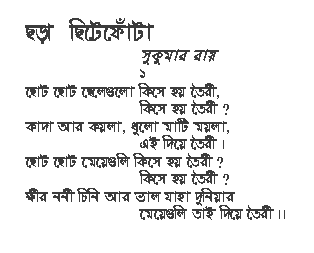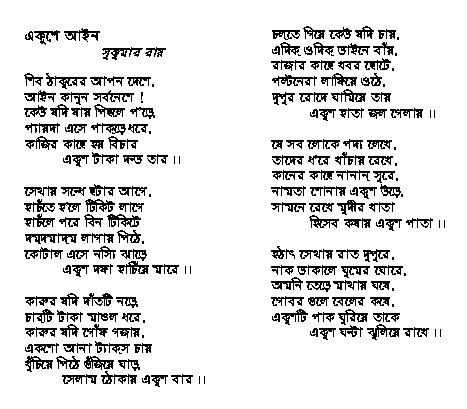The Rebel Prodigy
It was very recently in 15th August I was surprised to see that this great mind, son of soil was not remembered. Perhaps we would have celebrated his works more, if he had lived to be a man and didn't die at a very young age of 21.
He was true prodigy and in this short time that he lived and he had already created some brilliant masterpieces with his poems and plays. Along with the Nobel Laureate Rabindranath Thakur, Great Poet Kazi Nazrul Islam. Sukanta was one of the pillar of modern Bengali Literature. He took a strong rebellious stance against the tyranny of the British Raj and the oppression by the social elites through the work of his poetry.
Sadly most of his works got famous after his death, and established his place in the Bengali culture
His works reflected his principles of humanism, patriotism, his socialist thoughts, yet there was tremendous romanticism in his works.
His Growing Up
Sukanta Bhattacharya was born on 15 August 1926 to Nibaran Chandra Bhattacharya, owner of Saraswat Library, a publishing and book selling enterprise, and Suniti Devi. He was the second of their seven sons, Manomohan, Sushil, Prashanta, Bibhash, Ashoke and Amiya being the other six sons. Manomohan was Nibaran Bhattacharya's eldest son from his first marriage. Sukanta was closely associated with Manomohan and his wife Saraju Debi. Buddhadeb Bhattacharya, the former Chief Minister of West Bengal is his nephew—the son of his first cousin. Sukanta was born at his maternal grandfather’s house at Kalighat, Calcutta (now Kolkata, West Bengal), although his family hailed from the village of Kotalipara in Gopalganj of modern day Bangladesh." I did love Kolkata as a mysterious woman, the beloved, my mother...I don't the outside world, my world is Kolkata... I do want to live, but I'm certain that the death of Kolkata will bring my end"
Sukanta spent his childhood at their house at Nibedita Lane, Bagbazar. He was sent to Kamala Vidyamandir, a local primary school where his literary career began. His first short story was published in Sanchay, the school’s student magazine. Later another of his prose writing, "Vivekanander Jibani", was published in Sikha, edited by Bijon Bhattacharya.
"Radio, books, sports—so many means to spend time, but what I like most is the leafy sunshine amidst the Debdaru"
After studying at Kamala Vidyamandir, he got admitted to Beleghata Deshbandhu High School. He joined the Communist Party of India in 1944. In the same year, he edited an anthology, named Akal (Famine) published by the Anti-Fascist Writers' and Artists' Association. He was a close friend of the poet Shubhas Mukhopadhyay. In 1945, he appeared in the entrance examination from Beleghata Deshbandhu High School but failed. He was the editor of the Kishore Sabha (youth section) of the Bengali daily organ of the party, Dainik Swadhinata from its inception in 1946. He died of tuberculosis at the Jadavpur T. B. Hospital (later, K. S. Roy T. B. Hospital) in Calcutta at a very young age of 21. A comprehensive account of the poet's life can be found in Kabi Sukanta Bhattacharya O Sei Samay written by the poet's youngest brother, Amiya Bhattacharyya.
(Source - Wikipedia).
The Jewels in Sukanta's Crown.
Sadly he could witness only one if his work " Charpatra " being published during his short lifespan.Charpatra :
It was a Brillinat creation when it came out in 1948, and was targeted for the struggling poorer worker class of people, highlighting their pains and thier world.
"A new child is born; we will have to make room for him." "I shall make this world a fit place for him to live in"
Another Extract from the poem Mahajibon Translated ...
" Poetry, we do not need you any more.
A world devastated by hunger is too prosaic,
The full moon now reminds us of toasted bread "....
His Other Works are as brilliant as the First one and makes one feel the brilliance, the heart, the soul of a young prodigy who sadly died of tuberculosis at such a young age.
Ghum Nei (ঘুম নেই) (Sleepless, 1954)
Purbabhas (পূর্বাভাস) (Premonition, 1950)
Abhijan (অভিযান) (Expedition, 1953, a play)
Mithe-Kadha (মিঠে-কড়া) (Sweet and sour 1951)
Giti Guccha (গীতিগুচ্ছ) (Songs1965)
This works can be reached at :
http://www.kolkata-online.com/bangla/sukanta/
Sukanta Samagra (সুকান্ত সমগ্র) (Complete Works of Sukanta) (1967), published by the Saraswat Library, Kolkata was edited by Subhash Mukhopadhyay. This includes all the printed texts, some lesser known writings, his plays and stories, which include Khudha (Hunger), Durboddho (Incomprehensible), Bhadralok (Gentleman) and Daradi Kishorer Svapna (Dream of a Compassionate Adolescent), an article, Chhanda O Abritti and also a selection of lettrs




































